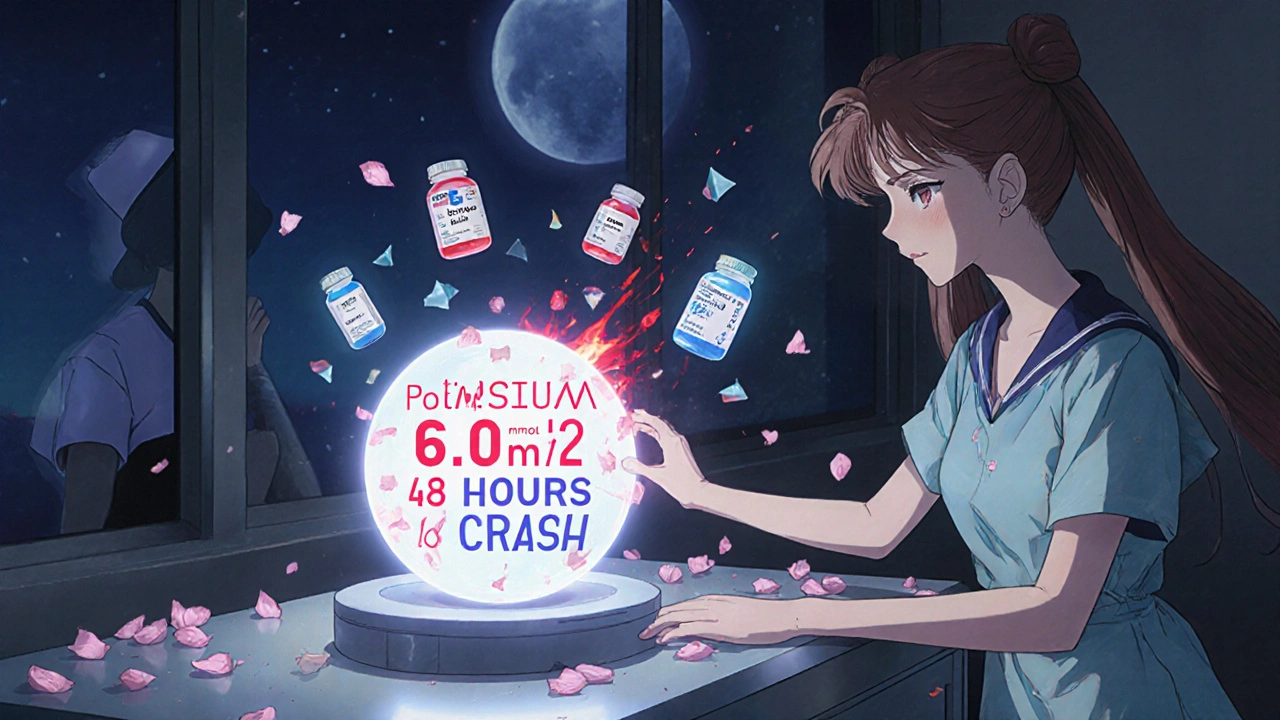Diuretics: Understanding Electrolyte Changes and Dangerous Drug Interactions
 Nov, 14 2025
Nov, 14 2025
Diuretic Interaction Checker
Check Your Medication Risks
Diuretics can cause dangerous electrolyte imbalances when combined with other medications. This tool identifies high-risk combinations based on medical evidence.
Diuretics are among the most commonly prescribed medications for high blood pressure, heart failure, and fluid retention. But behind their effectiveness lies a hidden risk: electrolyte changes that can turn life-saving into life-threatening. And when combined with other drugs, the danger multiplies. This isn’t theoretical. Every year, thousands of patients end up in emergency rooms because of electrolyte crashes caused by diuretics - often because the interactions weren’t properly monitored.
How Diuretics Work - And Why They Disrupt Your Electrolytes
Diuretics don’t just make you pee more. They target specific parts of your kidneys to block sodium reabsorption. When sodium leaves the body, water follows. But sodium doesn’t travel alone. It’s tied to potassium, chloride, and sometimes calcium. When you mess with sodium, you mess with everything else.
Loop diuretics like furosemide hit the thick ascending limb of the loop of Henle. They’re powerful - they can flush out 20-25% of filtered sodium. That’s why they’re used in severe heart failure or kidney disease. But they also dump potassium like crazy. In fact, studies show patients on loop diuretics are more than twice as likely to develop dangerously low potassium (hypokalemia).
Thiazides, like hydrochlorothiazide, work lower down - in the distal tubule. They’re gentler, removing only 5-7% of sodium. But here’s the twist: they’re far more likely to cause hyponatremia (low sodium). Why? Because they impair the kidney’s ability to dilute urine. Water stays, sodium gets washed out. This is especially risky in older adults, particularly women. One study found hyponatremia was the leading cause of hospitalization from thiazide use.
Potassium-sparing diuretics like spironolactone do the opposite. They block aldosterone, so sodium leaves but potassium stays. Sounds good - until you realize they can push potassium too high. Hyperkalemia (potassium above 5.0 mmol/L) can cause heart arrhythmias, cardiac arrest, even death. The FDA warns that up to 14% of heart failure patients on spironolactone develop dangerous hyperkalemia within weeks.
Drug Interactions That Can Kill
Diuretics don’t work in isolation. Their interactions with other drugs are where things go wrong - fast.
NSAIDs like ibuprofen or naproxen reduce blood flow to the kidneys. When you take them with a loop diuretic, the diuretic’s effect can drop by 30-50%. You think you’re getting relief from swelling, but your kidneys are struggling. You might not even realize it until your creatinine spikes or your blood pressure shoots up.
ACE inhibitors and ARBs - common in heart failure and diabetes - seem helpful. They reduce potassium loss from thiazides. But combine them with spironolactone? That’s a recipe for hyperkalemia. One meta-analysis showed serum potassium jumped 1.2 mmol/L when these were combined - enough to trigger cardiac arrest in older patients or those with kidney disease.
Antibiotics like trimethoprim-sulfamethoxazole (Bactrim) are a silent killer. They block potassium excretion in the collecting duct - just like spironolactone. When a 72-year-old with heart failure takes Bactrim for a UTI while on 50mg of spironolactone, potassium can rocket to 6.8 mmol/L in just 3 days. That’s not rare. It’s textbook. And it happens more often than doctors admit.
Even newer drugs like SGLT2 inhibitors (dapagliflozin) - used for diabetes and heart failure - interact in surprising ways. They increase sodium delivery to the loop of Henle, making loop diuretics work better. That’s good - but it also increases the risk of dehydration and acute kidney injury if not managed carefully. One trial showed the combination boosted natriuresis by 190% - meaning you could lose 2 liters of fluid in a day without realizing it.
When Diuretics Stop Working - And What To Do
Diuretic resistance isn’t a myth. It’s a physiological response. After 3-5 days of daily diuretic use, your kidneys compensate. The distal tubule starts reabsorbing more sodium. You’re taking the same dose, but the swelling doesn’t go down.
The solution? Sequential nephron blockade. Add a thiazide like metolazone to a loop diuretic. This combination targets two different parts of the kidney. In the DOSE trial, 68% of patients responded - compared to just 32% on loop diuretics alone.
But here’s the catch: this combo is a double-edged sword. A 2017 study found 22% of patients developed acute kidney injury and 15% had severe hyponatremia. That’s why it’s only used in hospitals or under close supervision. You can’t just crank up the dose and hope for the best.
There’s a better way: use biomarkers. If your urinary aldosterone is high, you need a potassium-sparing agent. If your fractional excretion of chloride is above 0.5%, adding a thiazide helps. This isn’t guesswork anymore - it’s precision medicine.

Monitoring: The Only Way to Stay Safe
There’s no magic pill for preventing electrolyte disasters. Only vigilance.
When you start a diuretic, get your electrolytes checked within 3-7 days. Not in a month. Not when you feel dizzy. Within a week. If you’re on multiple diuretics or have kidney disease, check every 24-48 hours during dose changes.
For elderly patients, start low. Use 12.5mg of hydrochlorothiazide - not 25mg. For loop diuretics, dose by kidney function: 1mg/kg if your eGFR is 30-60, 1.5mg/kg if it’s below 30. Don’t use a one-size-fits-all dose.
And if you’re on spironolactone? Check potassium within one week. The European Medicines Agency made this mandatory after realizing how common dangerous spikes were. Yet many doctors still wait a month.
What’s Changing - And What’s Next
Diuretics are evolving. In January 2024, the FDA approved a new combo pill: furosemide 40mg + spironolactone 25mg. Called Diurex-Combo, it’s designed to prevent potassium loss while still removing fluid. The DIURETIC-HF trial showed it cut heart failure readmissions by 22% and electrolyte emergencies by more than half.
SGLT2 inhibitors are now part of the standard heart failure toolkit. The 2023 ACC/AHA guidelines recommend adding dapagliflozin 10mg daily to loop diuretics. It reduces diuretic needs by 28% - meaning fewer side effects overall.
Future tools? AI-driven dosing algorithms. Mayo Clinic’s pilot study showed AI could predict electrolyte crashes 48 hours in advance by analyzing trends in labs, weight, and medications. That’s not sci-fi - it’s coming soon.
But for now, the most powerful tool remains: knowing the risks, checking labs, and asking - what else is this patient taking?

Real Stories, Real Consequences
A 68-year-old woman with hypertension started hydrochlorothiazide. Three weeks later, she collapsed at home. Her sodium was 122 mmol/L. She spent 10 days in the ICU. She didn’t know NSAIDs were risky. She’d been taking ibuprofen for arthritis.
A man with heart failure took spironolactone for years. When he got a sinus infection, his doctor prescribed Bactrim. Two days later, his heart stopped. His potassium was 6.9. His family didn’t know antibiotics could kill him.
These aren’t outliers. They’re predictable. And preventable.
Diuretics save lives. But they don’t play fair. They demand respect. And monitoring. And awareness.
Can diuretics cause low sodium? Which ones are most likely to do it?
Yes, diuretics can cause low sodium (hyponatremia), and thiazide diuretics like hydrochlorothiazide are the most likely culprits. They impair the kidney’s ability to dilute urine, so water builds up while sodium gets flushed out. This is especially common in older adults, women, and people taking higher doses. Loop diuretics like furosemide rarely cause hyponatremia - they tend to cause potassium loss instead. But when combined with other drugs like SSRIs or NSAIDs, even loop diuretics can contribute to low sodium.
Why do potassium-sparing diuretics cause high potassium?
Potassium-sparing diuretics like spironolactone and amiloride block aldosterone or sodium channels in the kidney’s collecting duct. Aldosterone normally tells the kidney to excrete potassium. When it’s blocked, potassium stays in the blood. This is intentional - it prevents the low potassium caused by other diuretics. But if you have kidney disease, take an ACE inhibitor, or use certain antibiotics like trimethoprim, your body can’t clear the extra potassium. That’s when levels climb to dangerous levels - above 5.5 mmol/L - risking heart rhythm problems or cardiac arrest.
Is it safe to take ibuprofen with a diuretic?
No, it’s not safe without close monitoring. NSAIDs like ibuprofen reduce blood flow to the kidneys by blocking protective prostaglandins. This makes diuretics less effective - sometimes by 50% - and increases the risk of acute kidney injury. It’s especially dangerous if you’re elderly, dehydrated, or have heart or kidney disease. If you need pain relief, acetaminophen is a safer option. Always talk to your doctor before mixing NSAIDs with diuretics.
What should I do if I feel dizzy or weak while on diuretics?
Don’t ignore it. Dizziness, weakness, muscle cramps, or irregular heartbeat could mean low potassium, low sodium, or low blood pressure. Stop taking the diuretic and call your doctor immediately. Get your electrolytes checked - don’t wait. These symptoms often appear before lab results show a problem. In emergencies, low sodium or high potassium can cause seizures or cardiac arrest within hours. It’s better to be safe than sorry.
Can I take a potassium supplement with a potassium-sparing diuretic?
No, unless your doctor specifically tells you to. Potassium-sparing diuretics like spironolactone already keep potassium in your body. Adding a supplement can push your levels into the dangerous range (above 5.5 mmol/L). Many patients have ended up in the ER with cardiac arrest after taking potassium pills on top of spironolactone. If you’re on a potassium-wasting diuretic like furosemide, your doctor may prescribe a supplement - but only after checking your blood levels. Never self-prescribe potassium.
Are there safer alternatives to diuretics for managing fluid retention?
For heart failure, SGLT2 inhibitors like dapagliflozin are now preferred as first-line therapy alongside diuretics - they reduce fluid retention without causing electrolyte imbalances. For mild swelling, lifestyle changes like reducing salt intake, elevating legs, and wearing compression socks can help. In cirrhosis, albumin infusions combined with low-dose diuretics work better than high doses alone. But for severe fluid overload, diuretics remain essential. The goal isn’t to avoid them - it’s to use them smarter, with better monitoring and smarter combinations.
Next Steps: What You Should Do Today
If you’re on a diuretic:
- Check your most recent blood test. Did they check potassium and sodium? If not, ask for it.
- Review all your medications. Are you taking NSAIDs, antibiotics, or ACE inhibitors? These can interact dangerously.
- Know your symptoms. Dizziness? Muscle cramps? Irregular heartbeat? Don’t wait - get checked.
- Ask your doctor: Is my diuretic dose right for my kidney function? Am I on a combination that’s too strong?
- Keep a log of your weight daily. A sudden gain of 2kg in 2 days means fluid is building up - call your doctor.
Diuretics aren’t the problem. The problem is treating them like harmless pills. They’re powerful tools - and they demand respect. Monitor. Ask questions. Know the risks. Your life might depend on it.

Kihya Beitz
November 15, 2025 AT 05:23Jennifer Walton
November 15, 2025 AT 06:22John Foster
November 15, 2025 AT 23:53Edward Ward
November 17, 2025 AT 02:52Andrew Eppich
November 18, 2025 AT 23:17Jessica Chambers
November 19, 2025 AT 20:17Shyamal Spadoni
November 20, 2025 AT 04:49Ogonna Igbo
November 21, 2025 AT 02:11BABA SABKA
November 22, 2025 AT 01:54Chris Bryan
November 22, 2025 AT 21:52Jonathan Dobey
November 24, 2025 AT 05:58ASHISH TURAN
November 24, 2025 AT 18:25Ryan Airey
November 24, 2025 AT 22:19Hollis Hollywood
November 25, 2025 AT 08:01